Nuclear Technology Review 2011 - IAEA
Nuclear Technology Review 2011 - IAEA
Nuclear Technology Review 2011 - IAEA
You also want an ePaper? Increase the reach of your titles
YUMPU automatically turns print PDFs into web optimized ePapers that Google loves.
FIG. III-2. Field work at a coastal aquifer in Peru.<br />
a horizontal or lateral gradient (age increasing with distance from area of<br />
recharge). In the former case this gradient is approximately proportional to the<br />
inverse of the recharge rate (volume/time), while in the latter case the gradient is<br />
approximately proportional to the inverse of the flow velocity. Therefore, the<br />
hydrogeologically relevant parameters primarily addressed by groundwater<br />
dating with radioactive isotopes are the recharge rate and flow velocity of<br />
groundwater in unconfined and confined aquifers, respectively.<br />
One of the approaches to determine groundwater flow rate is to estimate<br />
flow velocity by measuring the decrease in the radioisotope concentration along<br />
the flow path. If the mean porosity value of the aquifer is known, groundwater<br />
flow rate can be estimated. This simple approach requires access to at least two<br />
wells along the flow path of an aquifer and knowledge of the initial radioisotope<br />
concentration in the recharge area (Fig. III-2).<br />
Under natural conditions, groundwater movement is generally very slow,<br />
often in the order of a few metres per year. Water that has moved a few kilometres<br />
81

















